Notebook of Gerard Henderson Cowan - Part 10
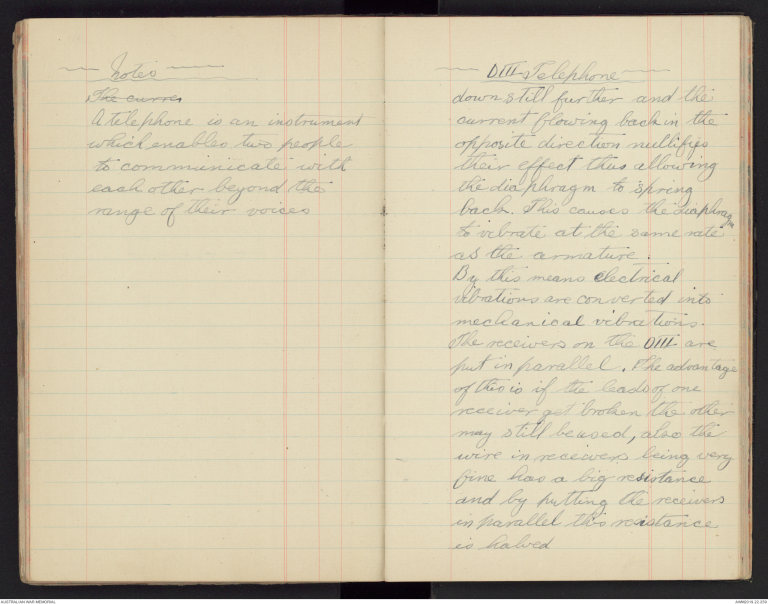
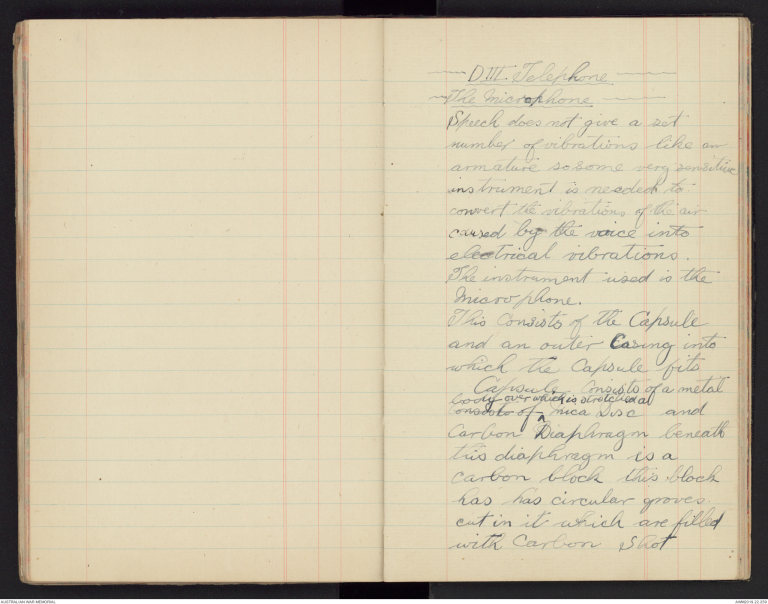
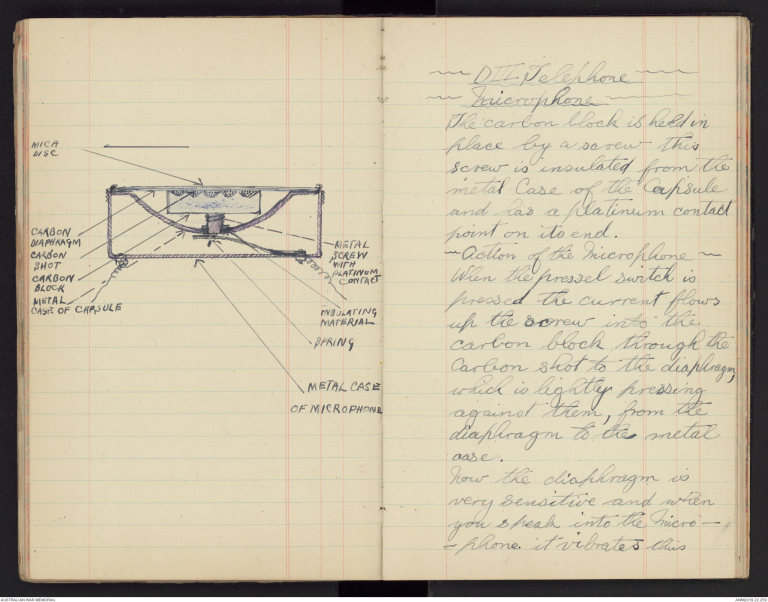
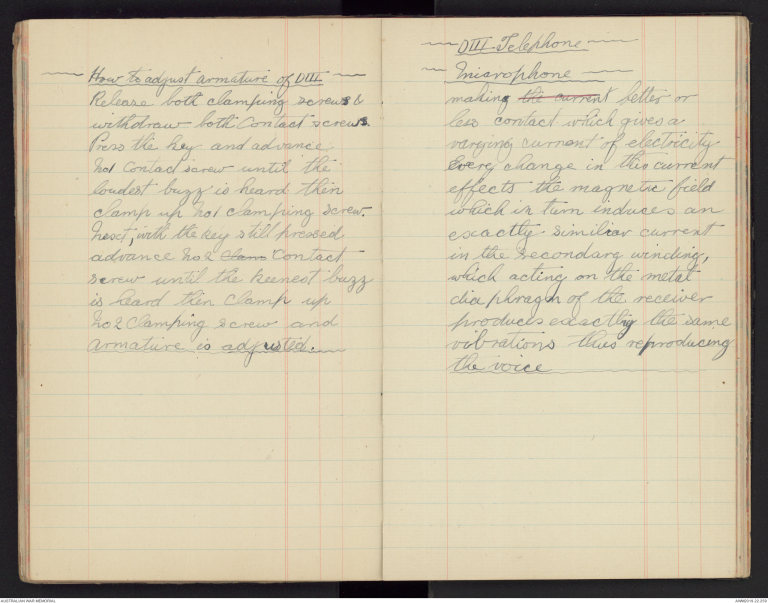
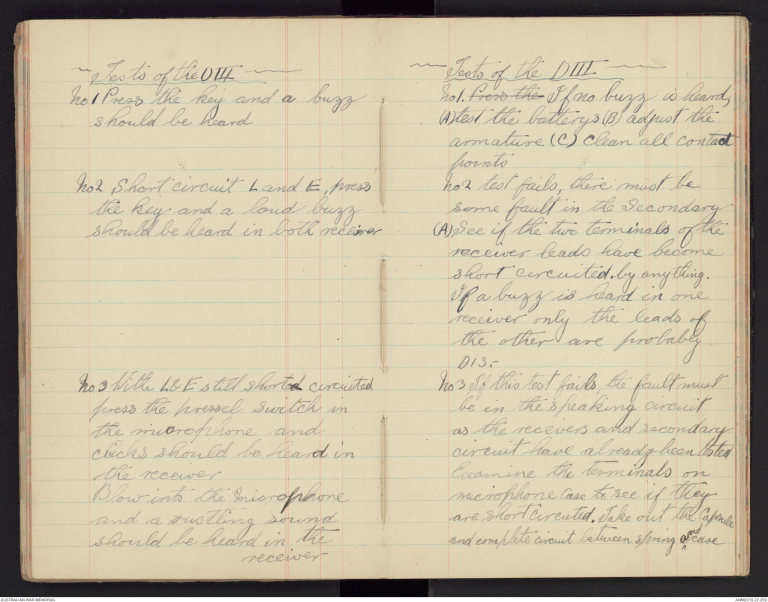
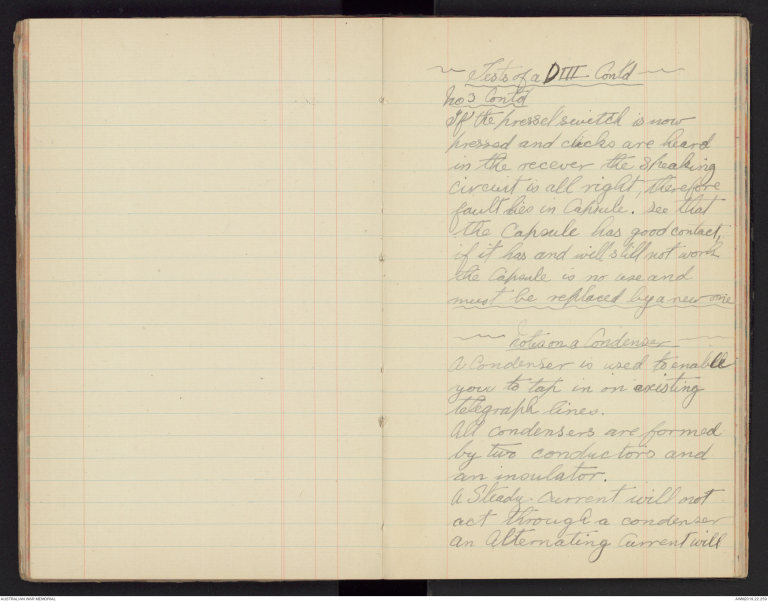
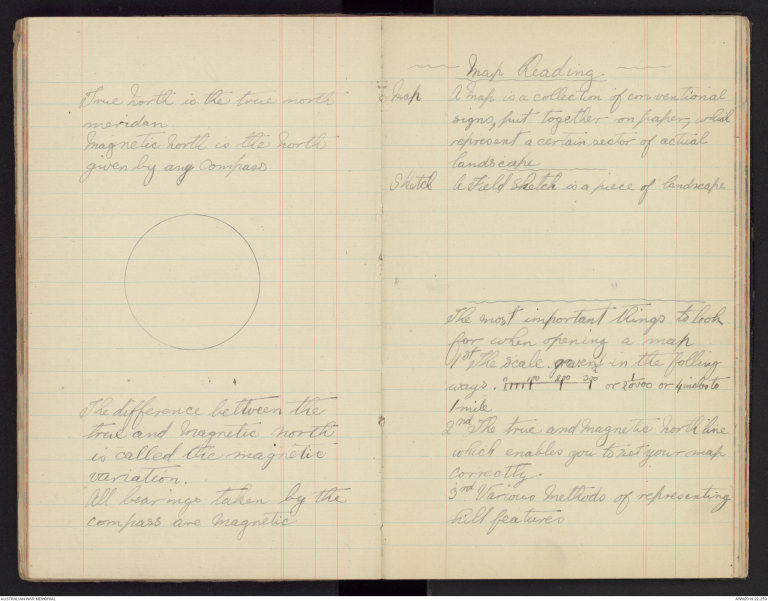
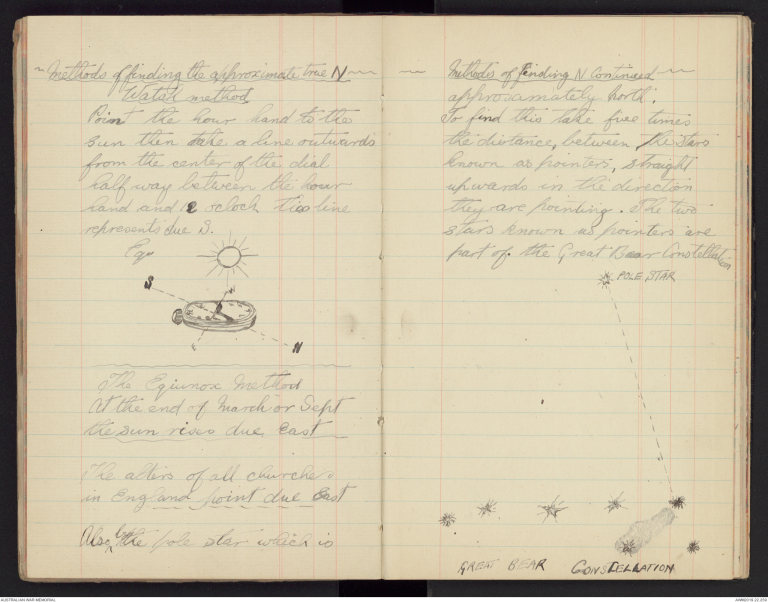
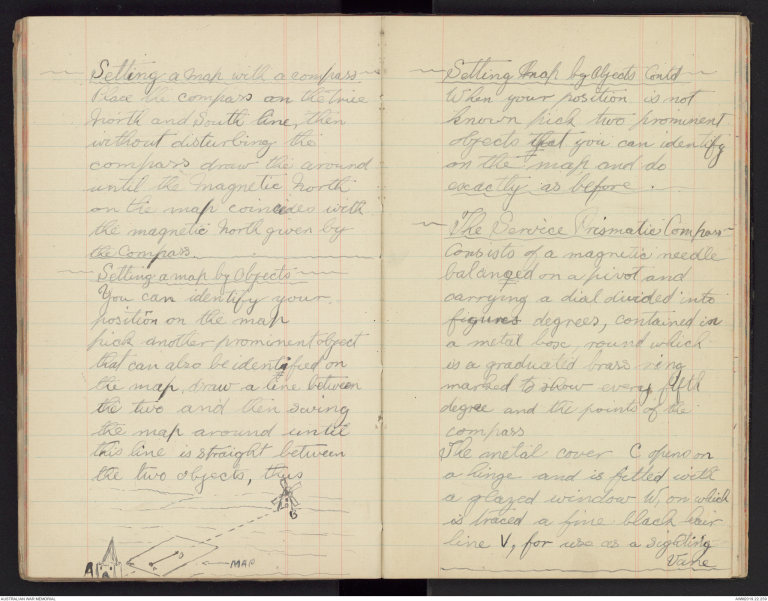
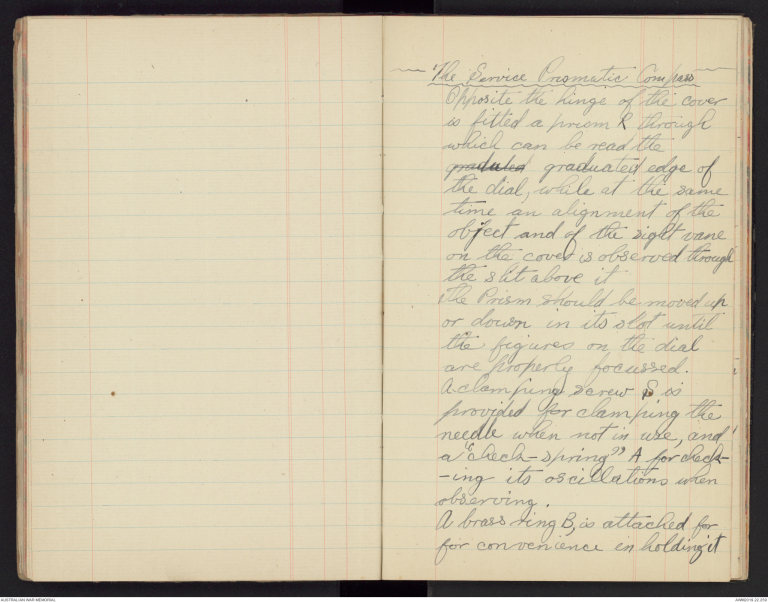
NotesThe curre
A telephone is an instrument
which enables two people
to communicate with
each other beyond the
range of their voices.
D III Telephone
down still further and the
current flowing back in the
opposite direction nullifys
their effect thus allowing
the diaphragm to spring
back. This causes the diaphragm
to vibrate at the same rate
as the armature.
By this means electrical
vibrations are converted into
mechanical vibrations.
The receivers on the D III are
put in parallel. The advantage
of this is if the leads of one
receiver get broken the other
may still be used, also the
wire in receivers being very
fine has a big resistance
and by putting the receivers
in parallel this resistance
is halved
- D III Telephone -
The Microphone.
Speech does not give a set
number of vibrations like an
armature so some very sensitive
instrument is needed to
convert the vibrations of the air
caused by the voice into
electrical vibrations.
The instrument used is the
Microphone.
This consists of the Capsule
and an outer Casing into
which the Capsule fits
Capsule consists of a metalxxxxof ^body over which is stretched a mica Disc and
Carbon Diaphragm beneath
this diaphragm is a
carbon block this block
has has circular groves
cut in it which are filled
with Carbon Shot
Hand drawn diagram - see original
D III Telephone
Microphone
The carbon block is held in
place by a screw this
screw is insulated from the
metal Case of the Capsule
and has a platinum contact
point on its end.
- Action of the Microphone -
When the pressel switch is
pressed the current flows
up the screw into the
carbon block through the
carbon shot to the diaphragm,
which is lightly pressing
against them, from the
diaphragm to the metal
case.
Now the diaphragm is
very sensitive and when
you speak into the microphone
it vibrates this
How to adjust armature of D III
Release both clamping screws &
withdraw both Contact screws.
Press the key and advance
No 1 contact screw until the
loudest buzz is heard then
clamp up No 1 clamping screw.
Next, with the key still pressed
advance No 2 Clam Contact
screw until the keenest buzz
is heard then clamp up
No 2 clamping screw and
armature is adjusted
D III Telephone
Microphone
making the current better or
less contact which gives a
varying current of electricity.
Every change in this current
effects the magnetic field
which in turn induces an
exactly similiar current
in the secondary winding,
which acting on the metal
diaphragm of the receiver
produces exactly the same
vibrations thus reproducing
the voice
Tests of the D III
No 1 Press the key and a buzz
should be heard
No 2 Short circuit L and E, press
the key and a loud buzz
should be heard in both receiver
No 3 With L & E still shorted circuited
press the pressel switch in
the microphone and
clicks should be heard in
the receiver
Blow into the microphone
and a whistling sound
should be heard in the
receiver
Tests of the DIII
No 1 Press the If no buzz is heard,
(A) test the batterys (B) & adjust the
armature (C) Clean all contact
points
No 2 test fails, there must be
some fault in the Secondary
(A) See if the two terminals of the
receiver leads have become
short circuited by anything.
If a buzz is heard in one
receiver only the leads of
the other are probably
DIS.-
No 3 If this test fails the fault must
be in the speaking circuit
as the receivers and secondary
circuit have already been tested
Examine the terminals on
microphone case to see if they
are short circuited. Take out the Capsule
and complete circuit between spring ^and case
Tests of a DIII Cont'd
No 3 Contd
If the pressel switch is now
pressed and clicks are heard
in the receiver the speaking
circuit is all right, therefore
fault lies in Capsule, see that
the Capsule has good contact
if it has and will still not work
the Capsule is no use and
must be replaced by a new one
Notes on a Condenser
A Condenser to used to enable
you to tap in on existing
telegraph lines.
All condensers are formed
by two conductors and
an insulator.
A Steady current will not
act through a condenser
an Alternating Current will
True North is the true north
meridan
Magnetic North is the North
given by any compass
Hand drawn diagram - see original document.
The difference between the
true and magnetic north
is called the magnetic
variation
All bearings taken by the
compass are magnetic
Map Reading
Map A map is a collection of conventional
signs, put together on paper, which
represent a certain sector of actual
landscape
Sketch A Field Sketch is a piece of landscape
The most important things to look
for when opening a map
1st The scale. given in the following
ways Hand drawn diagramme or 1/20000 or 4 inches to
1 mile
2nd The true and magnetic north line
which enables you to set your map
correctly
3rd Various methods of representing
hill features
Methods of finding the approximate true N
Watch Method
Point the hour hand to the
sun then take a line outwards
from the center of the dial
halfway between the hour
hand and 12 o'clock this line
represents due S
Hand drawn diagram - see original document.
The equinox method
at the end of March or Sept
the sun rises due East
The alters of all churches
in England point due East
Also ^ by the pole star which is
Methods of finding N Continued
approximately North.
To find this take five times
the distance, between the stars
known as pointers, straight
up wards in the direction
they are pointing. The two
stars known as pointers are
part of the Great Bear Constellation
Hand drawn diagram - see original document.
GREAT BEAR CONSTELLATION
Setting a map with a compass
Place the compass on the true
North and South line, then
without disturbing the
compass draw this around
until the Magnetic North
on the map coincides with
the magnetic north given by
the Compass
Setting a map by Objects
You can identify your
position on the map
pick another prominent object
that can also be identified on
the map, draw a line between
the two and then swing
the map around until
this line is straight between
the two objects, thus
Hand drawn diagram - see original document.
Setting Map by Objects Contd
When your position is not
known pick two prominent
objects that you can identify
on the map and do
exactly as before
The Service Prismatic Compass
Consists of a magnetic needle
balanced on a pivot and
carrying a dial divided into
figures degrees, contained in
a metal box round which
is a graduated brass ring
marked to show every fifth
degree and the points of the
compass
The metal cover C opens on
a hinge and is fitted with
a glazed window W, on which
is traced a fine black hair
line V, for use as a sighting
vane
The Service Prismatic Compass
Opposite the hinge of the cover
is fitted a prism R through
which can be read the
graduled graduated edge of
the dial, while at the same
time an alignment of the
object and of the sight vane
on the cover is observed through
the slit above it
The Prism should be moved up
or down in its slot until
the figures on the dial
are properly focussed.
A clamping screw S is
provided for clamping the
needle when not in use, and
a "check-spring" A for checking
its oscillations when
observing.
A brass ring B, is attached for
for convenience in holding it
 Paula P.
Paula P.This transcription item is now locked to you for editing. To release the lock either Save your changes or Cancel.
This lock will be automatically released after 60 minutes of inactivity.